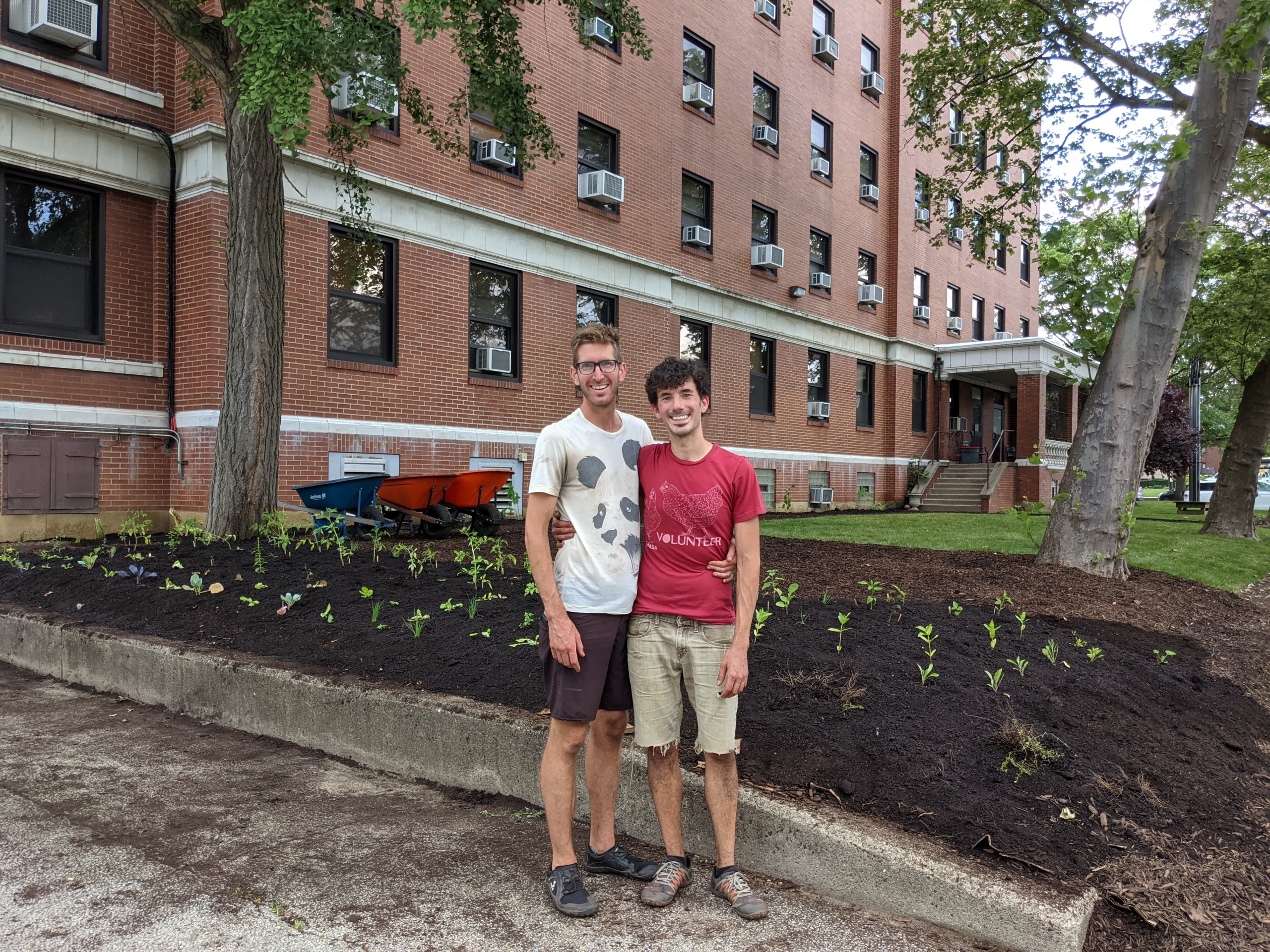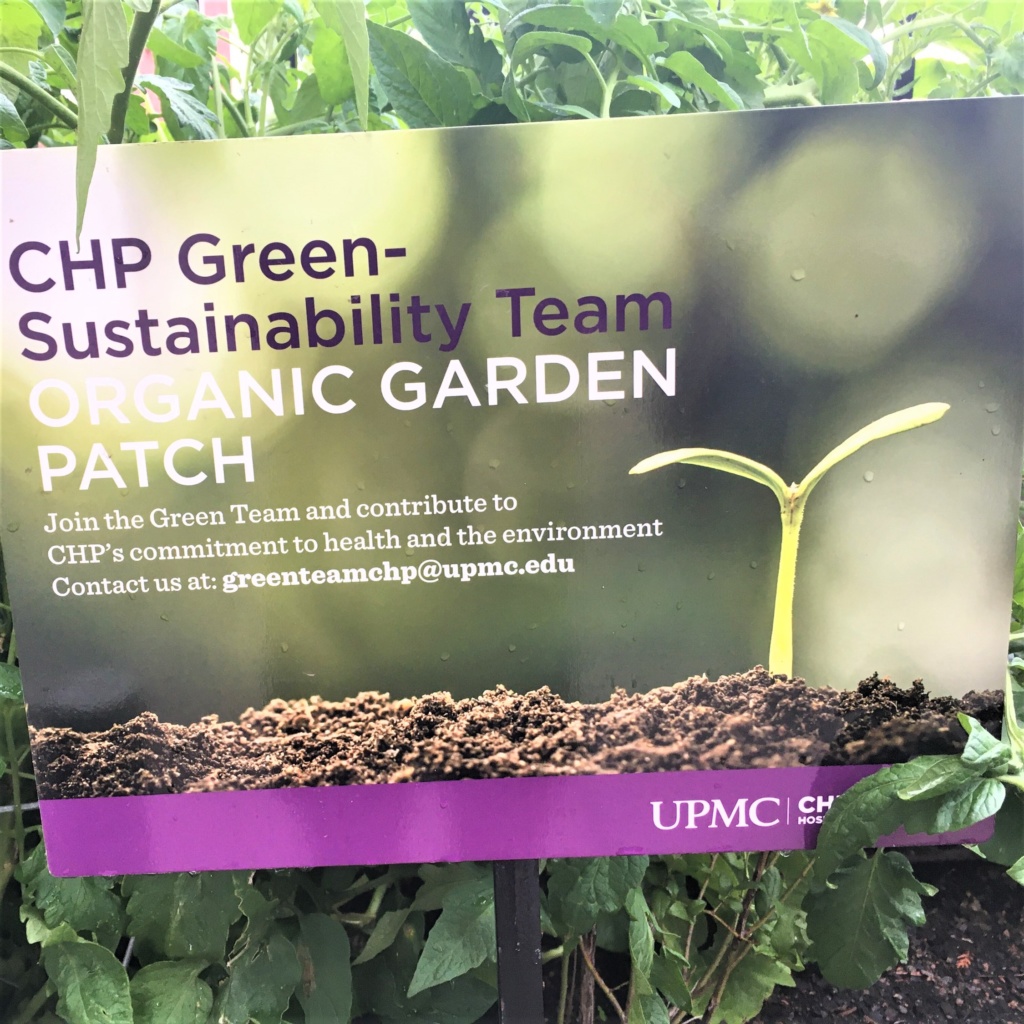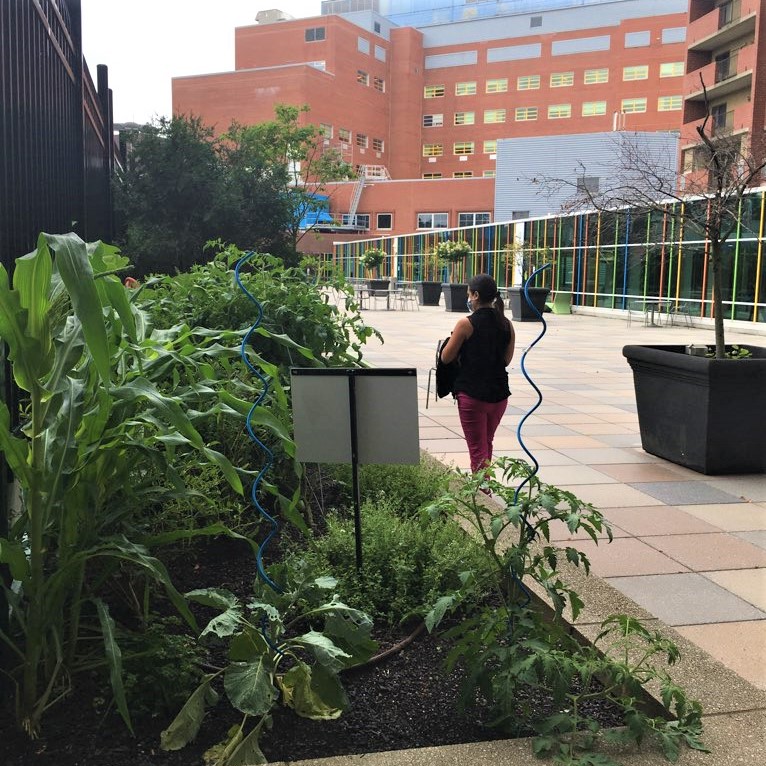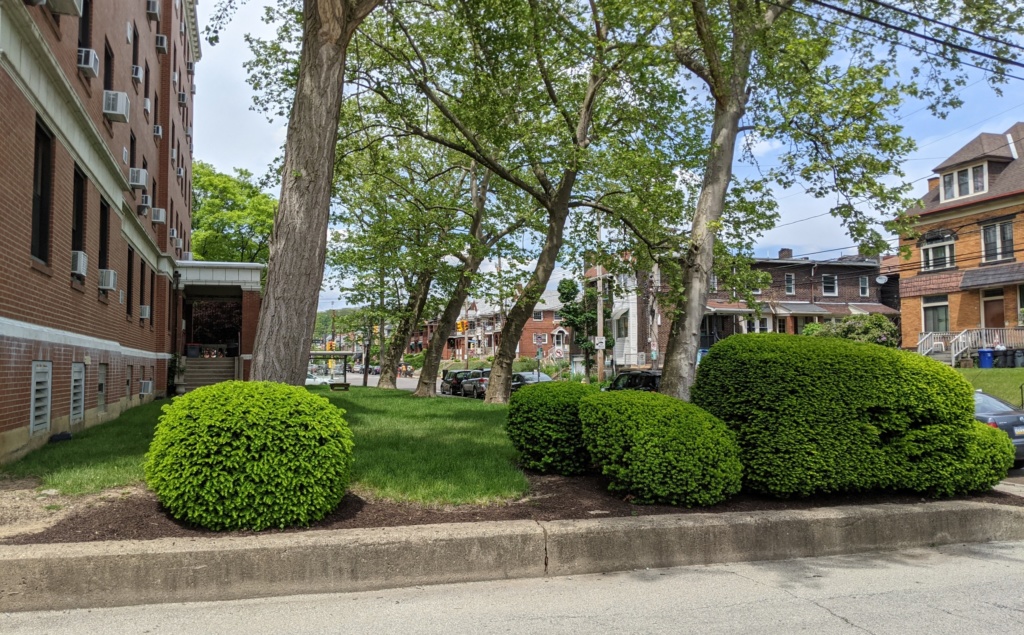Pittsburgh is known as a world class city for our hospitals, and soon, maybe its hospital gardens. For the eleventh installment of our Grower’s Spotlight, we’re taking you to the new hospital gardens at Children’s Hospital of Pittsburgh in Lawrenceville and West Penn Hospital in Bloomfield, and the gardening enthusiasts who spearheaded the efforts, Elena Kessler and Chris Kosin.
Be sure to follow Chris and Elena on their Instagram pages: @hallowedgroundhomestead and @elena_gardengal, respectively for beautiful garden and harvest shots and accessible gardening tips and advice. And Chris and partner Josh are hosting a workshop on maintaining a summer garden this Saturday! Check out the Eventbrite for more information.

Elena, pictured at the Children’s Hospital Organic Garden Patch

Chris (right) and partner Josh at the planting day for the West Penn Hospital garden
Gardens were a therapeutic respite for so many of us throughout the COVID-19 pandemic and what better place to grow one than in a hospital. Local healthcare workers and avid gardeners Chris Kosin and Elena Kessler did just that.
Kosin, a registered nurse and Manager of Hospital Operations at West Penn Hospital, and Kessler, a genetic counselor at Children’s Hospital of Pittsburgh, brought their extensive personal food growing experiences (about a decade each under their belts) to hand in creating these unconventional growing spaces.
Kosin and his partner Josh are behind Hallowed Ground Homestead, a lush garden oasis in their Lawrenceville backyard. Passionate about sharing his growing knowledge, Kosin has taught workshops for Grow Pittsburgh, among a number of other local organizations and businesses, that cover a wide variety of garden topics. The couple also made it their mission this past spring to get seedlings to as many gardeners as possible throughout the city, growing thousands of plants out of their home and offering them for pay-what-you-can, with all proceeds benefiting Grow Pittsburgh and the West Penn Hospital Garden.
Kessler and her partner also reside in Lawrenceville and have turned their small city backyard into an inspiring, high-yielding food growing space. She also enjoys getting others excited about growing, offering urban gardening consultations, as well as posting short, educational videos on her Instagram page. Having met in 2019 on the planning committee for the Lawrenceville Garden Tour, Kessler and Kosin made for seasoned collaborators to brainstorm and bounce ideas off of each other about their respective hospitals’ garden projects. “It is wonderful to have a like-minded and supportive friend doing similar work in the community. We both enjoy the educational and people based aspects of our garden projects,” says Kessler.
It’s evident that both Kosin and Kessler are not only seasoned growers but encouraging teachers and gardening advocates. To new growers looking for advice, Kessler says, “Try growing a few vegetables or herbs you enjoy in the first year. Starting small gives you a more manageable space to understand and learn. After that, you can tweak and expand.” Kosin encourages challenging yourself to just try. “If anything you will learn a new way not to do something and can enjoy the process of watching mother nature do miraculous things.”
Kessler and Kosin encourage patients and hospital visitors to check out these growing spaces and get inspired. “Pittsburgh has a kind growing community of folks who all want to share their knowledge with people just starting out. I hope we can embody that community in a hospital garden and use that energy to help heal people who need it most in times of weakness and stress,” says Kosin. Learn a bit more about these two inspiring urban growers, as well as the West Penn and Children’s Hospitals’ gardens below.
Before and After: The West Penn Hospital Garden is in its first growing season.
GP: When was your hospital’s garden created?
- Elena (Children’s): The Children’s Organic Garden Patch started in spring of 2019 and I began coordinating early this year
- Chris (West Penn): Our first growing season was just this year. COVID set the project back a year but we’ve started a small garden with a large expansion planned this fall.
GP: Where is the garden located?
- Elena (Children’s): The 3rd floor rooftop patio outside of the hospital cafeteria. We are growing in a 30×5 ft raised concrete bed and two 6x6ft large tree planters.
- Chris (West Penn): On Gross St next to the School of Nursing, with the expansion going in the vacant lot on Mend Way this fall.
GP: Who plants and maintains the garden?
- Elena (Children’s): Volunteers from the hospital staff who are part of the CHP Green Team. The Green Team has many other hospital invitiates they work on as well. Some of these include recycling of food waste and medical equipment, utilizing solar power on campus, planting trees, and working with dieticians and child life on garden to table education
- Chris (West Penn): Volunteers from the hospital staff are to maintain the garden space, I grew the majority of the plants in the initial garden, and the Healthy Food center will be harvesting the finished crops for their patients.
The CHP Organic Garden Patch sits on the hospital cafeteria’s rooftop patio


GP: What are you growing?
- Chris (West Penn): This first year, mostly herbs/spices for our patients to use in cooking (and to encourage less use of salt/oils/fats) and some educational crops to teach our patients to grow them at home. In future years, we hope to grow many vegetables to supplement our food pantry.
- Elena (Children’s): This year we have more than 20 varieties of vegetables and herbs! Veggies include bok choy, lettuce, kale, collards, celery, brussels sprouts, peppers, tomatoes, cucumbers, cauliflower, peas, squash, corn. Herbs include parsley, rosemary, oregano, sage, cilantro, basil. We are growing a loofah, and we have 6 blueberry bushes.
GP: What happens with the produce grown in the garden?
- Elena (Children’s): Produce is harvested and delivered directly to the hospital’s Executive Chef Joel Nagy. He uses it in cafeteria meals that are available to patients, families, and staff! Some of the produce will also be used in future educational workshops and TV shows with our dieticians and child life teams.
- Chris (West Penn): It gets distributed to patients of the Healthy Food center pantry. The long term plan is to possibly incorporate this food into the cafeteria foods during special events.
GP: How are these spaces similar to “traditional” community gardens?
- Chris (West Penn): It’s very similar to a community garden with the “community” in this case being our staff and patients who will receive the produce from the space.
- Elena (Children’s): Like conventional community gardens, we have a team of CHP community members planting, weeding, and watering. Many of our planted seeds came from this year’s CHP Seed Exchange, which was supported with many seeds from Grow Pittsburgh! Seedlings that were planted in the garden were all grown and donated from Green Team members and friends.
GP: What are your hopes for the garden space going forward?
- Chris (West Penn): I hope that we are able to help get produce into the hands of our food insecure patients. Long term plans are to host workshops in the smaller current space and possibly grow extra seedlings for our patients to take home in the spring. I hope to help close the gap for those who are seeking fresh cooking ingredients and empower those who are able to, to grow at home.
- Elena (Children’s): My hope is for more staff to be aware of the CHP Green Team, and get involved in one of the many hospital green initiatives! I also would love for the garden patch to be used for interactive gardening workshops with our inpatients, who are at the hospital 24/7.
GP: What’s your favorite thing to grow?
- Elena: We both love growing tomatoes, and grow a bunch of different varieties in our home gardens! This year, I’m growing 10 varieties, and Chris has more than 30! Apart from that, my favorite veggie to grow is Brussels sprouts. They take more than half a year to grow, and look really funky when they get tall.
- Chris: My new favorite plant to grow is Rudbeckia maxima, it will be the first year it will bloom in my garden.
GP: What’s the biggest lesson you’ve learned in your time gardening?
- Chris: Don’t be dogmatic and don’t take things too seriously, gardening is a growing experience, enjoy it first and learn from it second.
- Elena – be patient and don’t be too hard on yourself. Some plants will die, but many more will live, so try to grow something again the next year if it doesn’t work out as expected.
GP: What are some of your go-to growing resources?
- Elena: My favorite online community is ‘Humans Who Grow Food’. There are so many positive people and stories, and I love learning about unique ways to grow food around the world! Some of my favorite favorite books are The Essential Urban Farmer by Novella Carpenter and Willow Rosenthal, Month-By-Month Gardening in Pennsylvania by Liz Ball, and Square Foot Gardening by Mel Bartholomew.
- Chris: My favorite local resource is Grow Pittsburgh. Charles Dowding has many great no-nonsense manuals, and Meg Cowden from Seed to Fork is a great northern (MN) gardener who is constantly getting the most out of her short seasons. PASA, A Growing Culture,and Sarah Mock are great resources for getting into the regional and global agricultural challenges, and Allegheny Mountain Institute is a great example of what a hospital garden could be.
Know another local grower you’d like to see in the Growers Spotlight? Maybe it’s you! Drop us a line to be featured in our next newsletter or on our blog.


